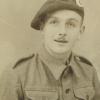Candahar Barracks was where the Para Squadron RAC were based during the three years I spent with them. On reflection I can honestly say that during those three years much of our time was spent away from Candahar barracks. It was the time when the troubles in Northern Ireland were beginning to escalate and as a result Aldergrove more often than not proved to be our second home.
Alternating between Tidworth and Northern Ireland kept the Squadron fairly busy but of course there were always other things that we became involved in, mostly exercises but latterly and towards the end of my tour with the Squadron the transition between the Hornet and Malkara missile to the Mk5 Ferret and Swingfire missile were to take place.
The last of the Malkara missiles
Northern Ireland apart the main feature for 1969 as far as the Squadron was concerned was to be the change over to the Mk5 Ferret with the Swingfire capability. It was long over due bearing in mind that the Malkara missile was one of the earliest anti tank guided missiles that we had and which was suitable for use by the Para Squadron RAC.
It was intended to be light enough to deploy with airborne forces yet powerful enough to knock out any tank then in service in that sense aims were achieved. At this point it has to be said that most systems have a life span and this was the case with the Hornet and the Malkara missile, it was time for change so it was that the Mk5 Ferret complete with Swingfire was introduced to the Para Squadron RAC
It was July 1969 when the Squadron found themselves in the Outer Hebrides. We were accommodated on Benbecula with access to South Uist and the firing point being gained via a short causeway.
The Hornets lined up on the firing point looked most impressive but that said and if I am to be completely honest was as far as it went. I have always thought that the Hornet was one of the ugliest pieces of armour ever to be introduced but seeing them lined up, missiles loaded and pointing out to sea you could not help but feel they would have been a force to be reckoned with, sadly and as previously mentioned they had come to the end of their life and as such there were numerous malfunctions that were about to take place.
The firing of the last of those Malkara missiles for me was a formality I was not a crew member merely part of the administration team responsible for ensuring things were in place prior to the actual firing of the missiles. For the crews it was a chance to put into practice all the dry training they had been subjected to in the months leading up to that moment in time, for myself I was just a spectator witnessing the last of the Malkara missiles being fired.
There must have been great disappointment when many of the missiles for what ever reason malfunctioned, one I remember in particular. No sooner had the missile been launched than it was in the sea leaping up and down like some giant porpoise trailing behind miles of wire, It has to be remembered that the Malkara Missile was large, cumbersome and wire guided, despite all the careful preparation it was inevitable that there was going to be a few problems with this ageing system.
For the crews I do not doubt the training and firing period on South Uist was invaluable but the performance of the out dated missiles left much to be desired to say nothing of the miles of wire that had to be gathered up after completion of the firing.
Although instrumental in the change over of the two firing systems I did not ever witness the firing of the Swingfire missile I could only imagine that it would have been a much improved system.
Account by Maj D A Buxton
Source: Maj D A Buxton
Read More



Latest Comments
There are currently no comments for this content.
Add Comment
In order to add comments you must be registered with ParaData.
If you are currently a ParaData member please login.
If you are not currently a ParaData member but wish to get involved please register.